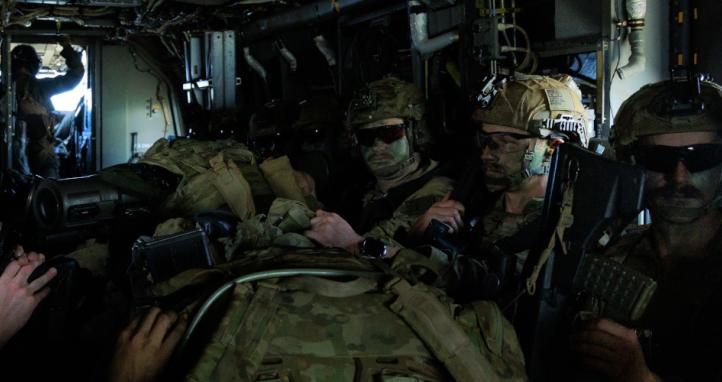A study published in the Journal of Population Studies in March 2023 estimated that one in six deaths in the US is linked to excess weight or obesity. The researchers concluded that, "Existing studies have likely underestimated the mortality consequences of living in a country where cheap, unhealthy food has grown increasingly accessible, and sedentary lifestyles have become the norm"[1]. I would argue that Australia has similar norms.
Our nation has one of the highest rates of obesity in the world, in 2017-19 Australia was ranked fifth among OECD countries with one third of Australian adults living with obesity[2].
According to the ABS National Health Survey, 67% of Australian adults were overweight or obese (12.5 million people) in 2017-18, an increase from 63.4% in 2014-15. This study also found that 50% of 18-24 year olds were overweight or obese. The report’s authors extrapolated that if the current trend continues, more than 18 million Australians will be overweight or obese by 2030. The financial and other costs of obesity are significant, estimated to be around $11.8 billion in 2018 and will likely continue to rise, with the cost being around $87.7 billion in 10 years [3].
Many Australians consume more energy than they need through unhealthy diets that are high in sugar, saturated and/or trans fats, and alcohol. These diets are high in discretionary foods such as processed meats, savoury pastries, fried foods, confectionery, cakes, biscuits, and soft drinks. The Australian Dietary Guidelines state that healthy diets are based on whole foods, such as vegetables, fruit, wholegrain cereals, nuts, seeds, dairy products and alternatives, lean meat, chicken, fish, eggs, tofu, and legumes[2].
Obesity and low levels of physical activity are major risk factors for chronic health conditions. These people have a greater risk of developing cardiovascular disease, type 2 diabetes, osteoporosis, and dementia[2].
Obesity in overseas militaries
The prevalence of overweight and obese soldiers is a major issue that affects militaries across the world. According to numerous international studies, despite stringent bodyfat standards and physical fitness requirements, many nations are encountering higher levels of overweight and obese soldiers in their armed forces. This issue impacts the ability of militaries to attract and train new soldiers and affects operational effectiveness.
It is unlikely that young men and women who are obese will make it through the ADF recruitment process. This reduces the cohort of potential members and may lead to shortfalls in desired recruitment numbers, at a time when we need more people to enlist.
The US identified this as an emerging issue more than a decade ago. In 2012, Lieutenant General Mark Hertling, then Commanding General of US Army Europe, identified obesity as an impending threat to the US, and stated that it will affect their nation’s youth, economy, and future[4]. More recently he added, “The military has experienced increasing difficulty in recruiting soldiers as a result of physical inactivity, obesity, and malnutrition among the nation’s youth. Not addressing these issues now will impact our future national security.”[5].
In 2018 Major General Allen Batschelet, then in charge of the US Army Recruiting Command, stated that the biggest single reason for failing to meet the US enlistment requirements at that time was obesity. He also stated that this was becoming a national security issue, and said, “The obesity issue is the most troubling because the trend is going in the wrong direction,” and that, “It’s a sad testament to who we are as a society right now”[6].
Being ‘Not fit to serve’ is a major issue for the US military. Individuals in the 17-24 age range account for 90% of US military applicants; however, in 2018 71% of young people in the US were not fit to join the military if they wanted to, with the five main reasons being overweight, obesity, having a low education, using drugs, and having a criminal record[5].
In a US study published in 2015, the combined overweight and obesity levels in active-duty personnel rose to more than 60% between 1995 and 2008. The authors stated that the high prevalence of military personnel being overweight and obese needs urgent attention and has implications for Department of Defense efforts to improve the health, fitness, readiness, as well as quality of life for active-duty forces[7].
In a more recent US study published by Military Medicine in 2022, it was found that there are more active-duty service members with an overweight body mass index (BMI; 25–29.9 kg/m2) than any other BMI category (at 51.6%), with another 15.1% classified as obese. Only 33.3% were classified as in the normal weight range[8].
Obese soldiers also appear to have more injuries. Between 2008 and 2017, active-duty soldiers in the US had more than 3.6 million musculoskeletal injuries. Active-duty soldiers with obesity were 33% more likely to suffer musculoskeletal type injuries[5].
In 2013 the British Army conducted an observational study of 50,635 troops. The results of the study, according to BMI levels, found that 56.7% of the troops were overweight and of those individuals, 12% were obese[9].
In a study published in 2022, the French military conducted a study between September 2016 and April 2017 of 1,589 service members and found the prevalence of being overweight or obese was, respectively, 38.7% and 10%. Age, sex, weekly fitness activity, and rank were significant independent predictors of excess body weight. The study found that the rates were lower than most other nation’s militaries[10].
The Australian Army
Like other militaries, the ADF is not immune to the obesity issue. Recently the ADF came up with a novel approach to measure obesity levels in Army. This involved using uniform waist size as a proxy to estimate the number of members that were overweight or obese. Army had been progressively replacing combat uniforms with a new camouflage uniform since 2016. The total number of combat uniforms issued by size was obtained from three Army Combat Brigades, from the first issue of the new uniforms in 2016 through to 2019. The waist size of issued combat pants was collated and adjusted for measured waist size and sex, and then analysed to estimate the proportion of overweight and obese soldiers.
The results were that for a total of 155,735 combat pants issued the average waist size, based on combat uniform pant size, was found to be 90.4 cm. From this data it was estimated that around 23.3% of Army personnel could be overweight and around 4.5% obese[11][12]. To have around 28% of our Army overweight or obese is not ideal and needs attention.
Conclusion
Being overweight or obese is an issue for our nation as well as Defence. If overweight and obesity trends continue as they are, this could affect Army’s recruitment, manning, and operational capability – which is a risk to Army. National and Defence programs aimed at addressing this issue need to be developed and implemented to combat this growing issue.










Three observations:
1) The statement: ‘It is unlikely that young men and women who are obese will make it through the ADF recruitment process’ is incorrect. Obesity is not a barrier to enlistment. The ADF allows enlistment at a BMI < 33; and this cut-off is not uncommonly waived…out of necessity.
2) The waist size study underestimates the prevalence of overweight and obesity in Army, It only looked at the three combat brigades. A holistic view would almost certainly reveal a significantly higher number (as would including all three Services).
3) There was a time (not so long ago) when the ADF MEC downgraded personnel (and even medically discharged them) for being obese. There would be a significant impact on ADF capability if this policy was still in place.
The reality is that the ADF does not consider obesity to be a medical issue until a member suffers from (an obesity-related) comorbidity. [ Just like smoking is not a medical issue until you get lung cancer.]
If Army/ADF considers that obesity is a problem, and wants to do something about it, a key first step is to address the organisational denial. You can’t fix a problem if there is no problem to fix.
There are two additional observations:
1. Australian society (or "the government") invests a large sum of money to promote Australians to maintain their health and well-being. This includes health promotion and information, preventative medicine (eg. vaccinations), sport and recreation facilities and programs, and even elite sport funding. This is in part to prevent or reduce the healthcare costs as individuals age.
But the other (less discussed) reason is that in times of total war, the highest possible health and fitness of the population available for enlistment and even conscription to fight is required (Bodies for Battle: US Army Physical Culture and Systematic Training, 1885-1957. Garrett Gatzemeyer. University Press of Kansas, 2021).
We should take note of the US Army's experience in WWII. The US Army was surprised by the high draft failure rate which was reflective of the American conscription population’s (male only) physical capability for war. Overweight and underweight were issues even then. Physical standards had to be progressively reduced just to keep up the demand for military personnel. Just to use one example, at the commencement of WWII, recruits had to have a minimum of 12 teeth - 6 in the upper jaw and 6 in the lower jaw. This was later reduced to 6 teeth, and eventually reduced to a recruit accepted for service through just being able to open and close his mouth without pain (Physical Standards in World War II. LTGEN Leonard Heaton, Office of the Surgeon General, Department of the Army, 1967).
2. All is not lost. There is considerable evidence that a little excess weight does not result in a significantly higher rate of health issues or an excess death rate. In fact, some research has concluded that people who are a little overweight actually have better health outcomes than those who are underweight or even healthy weight (based on the traditional BMI brackets of <25, 25-30, and >30). Largely overweight and obesity however continue to result in significant negative health outcomes (Excess deaths associated with underweight, overweight, and obesity. Flegal KM, et al. Journal of the American Medical Association 2005; 293(15)). There is also a lack of evidence correlating societal weight and societal physical fitness. We know people are getting fatter, but we have little evidence as to how that affects physical fitness on a broad scale.
As the author concludes; overweight and obesity could affect Army’s recruitment, manning, and operational capability; and this needs to be recognised and addressed. In addition, Army (and Defence) has a duty of care to its members - and that duty extends to post-service life. Certainly another issue of concern.
1. As a co-author of the pants size study published in BMJ in 2020 and referred to in the Cove article, I can confirm the following:
a. the study significantly underestimated the prevalence of obesity in combat brigades due to ADF AMCU being "comfort sized" ie; the waist size measuring larger than the labelled size by an inch or more.
b. The organisational backlash post publication was significant, with claims of “fat shaming” directed to the authors.
i. Of note on “fat shaming” the lifetime prevalence of eating disorders is approx 5%
ii. Compared to obesity and related illness affecting more than 30% of the population.
iii. Per capita morbidity and health care costs associated with obesity are only second to recreational inhaling of tobacco and other smoke.
c. There remains a myth BMI is not reflective of body composition. The BMI is an effective indicator of body composition in over 95% of our population and a useful screening tool.
i. A recent study of Australian SF candidates body composition using DEXA scanning showed 1 of 40 candidates had an obese BMI with normal body fat composition (approx. 2.5% of a sample representative of a minimum 2.5 positive standard deviations past Army’s collective physical performance mean of our members).
2. As a learned PhD qualified MO colleague pointed out "no research institution would give ethics approval for a prospective case control study between obese recruits and normal BMI recruits because all existing evidence indicates you would be inducing harm on exposure of obese people to the occupational and environmental hazards of the service environment". In civvy street obese individuals self-select out of tasks/situations that cause back, knee and ankle discomfort or any other of the multitude of conditions where obesity is a risk factor. They cannot do that in the military.
3. Ethically our organisational ignorance of the problem and “normalisation of BMI deviance” by making it a command responsibility in policy in 2018, is causing harm in not protecting the long term interests of our individuals / organisation/ government as follows:
a. Not protecting people from accelerating harm to themselves on exposure to the occupational and environmental hazards of the service environment.
b. Not ensuring we identify and implement preventative medicine strategies for those at risk.
i. ACT Government Health currently has more and better obesity health promotion material than the ADF, despite a several billion dollar contract with BUPA.
ii. Anthropometry for classification of obesity represents the least contemporaneous health data measurement recorded for our people on DeHS.
c. Not ensuring people get effective treatment for the condition.
d. Not protecting those normal and overweight BMI people from increased workload when obese people succumb to occupational and environmental hazards and cannot perform their role.
i. The significant increase of sick leave in the Australian and other developed nations workplaces for obese compared to non obese persons is well documented, including by the Australian Productivity Commission.
e. Not protecting the taxpayer from a current “blank cheque” trailing liability for post medical separation compensation and medical support for which no research data exists to indicate the cost of obesity related morbidity.
4. A quality assurance audit indicates obese Army personnel are significantly over represented (nearly 10 fold) among personnel presenting to the MECRB for consideration of continued employable/deployable function. As per the Royal Australian College of General Practitioner Guidelines for Preventative Activities in general practice, obesity is a known risk factor for many musculoskeletal and other conditions including depression. A quality assurance audit of J31 pers (if allowed) would find obese persons over represented at J3X MEC also.
5. This finding of increased risk ratio of obese individuals exposed to the occupational and organisational hazards of Army service presenting to MECRB with separating medical conditions is consistent with the recent 2022 meta-analysis indicating increasing BMI above 25 correlated to increasing morbidity in North American “tactical populations” of military and emergency first responders.
6. The Commonwealth Health ministers released Australia’s Obesity Strategy 2022 to 2032 for the Australian population. There has been no similar response from the ADF and it appears this problem has been ignored, as evidenced by the paucity of approved ADF research into obesity’s impact on our workforce……an “ISR shadow” if ever there was one.
7. Compared to RMC SCDT where I was instructing in 2006, there were no obese officer cadets at a certain very large officer training academy to our North I spent 2 months in as an ADF linguist in that same year. (I was also told at the time by everyone in CBR on RTA that particular military’s ambitions were unsustainable and capability would remain poor….when the opposite has since been the case)
8. As per this excellent article, we need action like that implemented by the US Defence Force to manage the impact obesity has on our current and future capability…..Lest we be destined to represent an “oversized” modern day parable of the “Emperor’s (supersized) New Clothes”.
A deeper dive into diet analysis would identify a systemic issues within Defence.
As you have identified above, there is a common stigma against saturated fats and a push for more grains, nuts and seeds amongst other things.
Restriction of saturated fats can be damaging to humans. Saturated fats are vital for hormone production, which is vital for the people of a high performance organisation. Some mainstream advice raises concerns around increased LDL; however, further analysis of the relationship of LDL to triglyceride levels would indicate that anybody living a healthy lifestyle should be happy to have what is typically considered elevated LDL. Not only will this have positive impacts for physical human performance as a result of hormone regulation, but it will also result in desirable cognitive benefits (noting that our brains comprise of 25% cholesterol).
There is a greater dietary issue around trans fats and polyunsaturated fatty acids, which in large quantities can cause genetic mutations, hormonal imbalances including reduced testosterone and progesterone, obesity and a range of illnesses and diseases. The biggest contributor of these fats is through seed and vegetable oils which were not originally designed for human consumption. The contracted companies who run our messes typically use cheap canola oil for all of their cooking, as do AAFCANS. Our personnel are, often unknowingly, consuming oxidated, carcinogenic oils in nearly every meal.
Your article has also identified that we should be consuming larger quantities of grains, nuts and seeds. While some people respond well to these food sources in moderation, it is important to note that they all contain large quantities of defence chemicals and phytoestrogens. If reducing the progesterone and testosterone production of our personnel through ingestion of industrial oils and the restriction of saturated fats doesn't eliminate their will to win, then high doses of gut-irritants and phytoestrogens will.